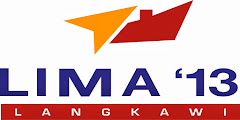31 Oktober 2013
KAI unveiled a single-engine version of the KFX technology demonstrator at ADEX 2013 in Seoul (photo : Jane's)
Korean Aerospace Industries (KAI) has developed a single-engined version of the Korean Fighter Xperiment (KFX) indigenous stealth fighter prototype in an effort to get the stalled programme back on track.
Officials at the Seoul Aerospace and Defence Exhibition (ADEX 2013) told IHS Jane's that the single-engined version, dubbed the C501, was a low-cost option that combined elements of the in-production FA-50 light fighter and the twin-engine KFX technology demonstrator, called the C103, that completed its technical development in 2013.
C501 model with double vertical stabiliser (photo : FlightGlobal)
The KFX programme was announced in 2001 and originally conceived as a twin-engine stealth multirole fighter with stealth characteristics. Technical development of the first prototype, dubbed C103, was completed in 2013 and South Korea entered an agreement with Indonesia in 2011 to share the cost of developing the platform. Initial operating capability for the KFX/IFX was planned for 2023.
However, budgetary constraints and concerns over the programme's risk led the new South Korean government of President Park Geun-hye to suspend the KFX/IFX programme in early 2013.
An industry source, who declined to be named due to the political sensitivity of the programme, said the Defense Acquisition Programme Agency (DAPA) and the Agency for Defense Development (ADD) believed the C103 technology demonstrator had "development risks - basically the stealth configuration means it could cost more money".
C501 model with double vertical stabiliser (image : Aviation Week)
He added that the government believed it was "a good plane", but the development risks were "great compared to the government's plans and so it had requested a 'practical' alternative". In response, KAI has developed the C501 prototype in single seat and dual seat versions.
The key differences between the C103 and the C501 are that the latter has a single vertical stabiliser, single engine and uses data, systems, and avionics developed for KAI's FA-50 - itself a development of the T-50 Golden Eagle lead-in fighter trainer. The C501 also lacks any internal weapon bays.
However, with the exception of the tail, the C103 and C501 planforms are almost identical, allowing wind tunnel data from the C103 to be used in the C501's conceptual design.
C501 model with single vertical stabiliser (photo : Flight Global)
The official described the C501 as a "more advanced, stealthier version of the Lockheed Martin F-16" that would fill a gap between the Lockheed Martin F-35 and FA-50 in Republic of Korea Air Force (RoKAF) service. The source added that based on market research, KAI also believed that the single-engine C501 version of the KFX would be an "attractive candidate" to international customers, including Western countries, looking to supplement their F-35 fleets with a lighter, cheaper option.
"The bottom line is that KAI is pursuing affordability in developing the KFX," said the official, who nonetheless warned that the C501 version was so far only a conceptual design model.
C501 model with single vertical stabiliser (image : Aviation Week)
For this to change, DAPA has to complete the FX-III programme - currently under review following the decision in late September not to purchase the Boeing F-15SE. "It all depends on FX-III," the official said. "The winner will provide technical assistance for the KFX programme."
The official said the KFX programme had an eight-and-a half-year engineering, manufacturing, and development (EMD) phase, with the Ministry of Finance allocating USD10 billion for this phase in its Fiscal Year 2014 budget request. If it is approved by the National Assembly and an FX-III contract is awarded, EMD will begin in November 2014.
(Jane's)
Langganan:
Posting Komentar (Atom)















Wow
BalasHapus